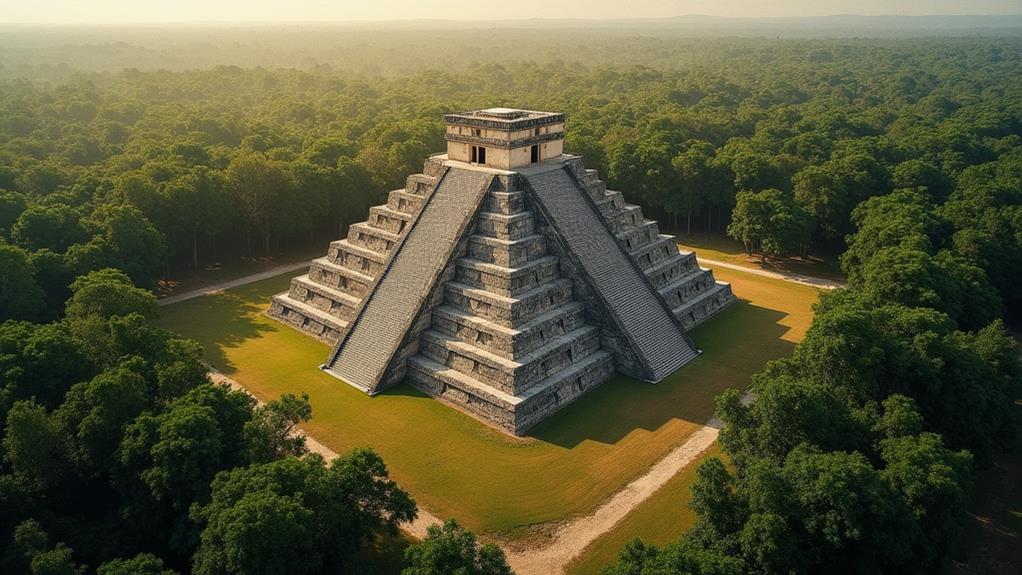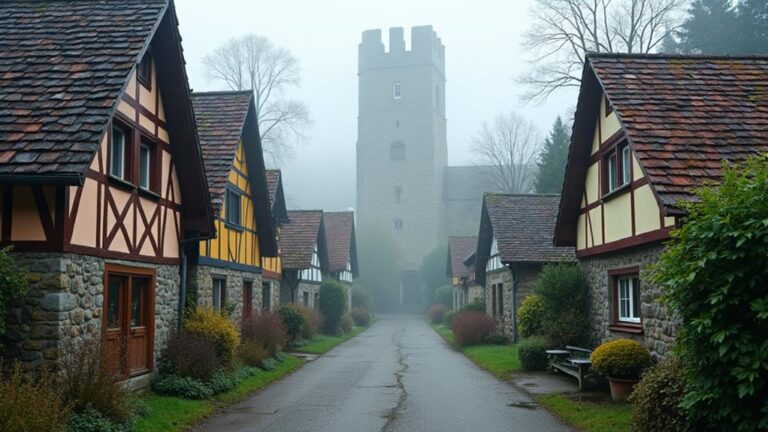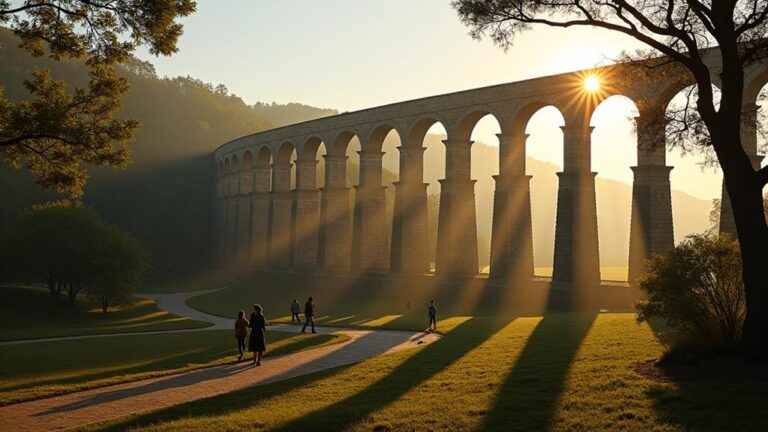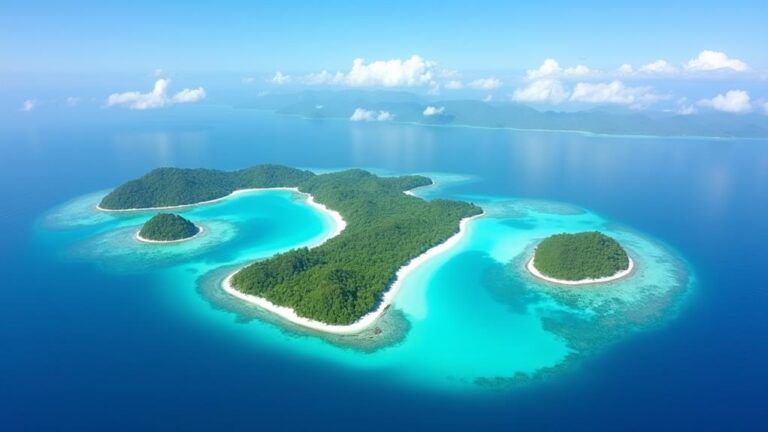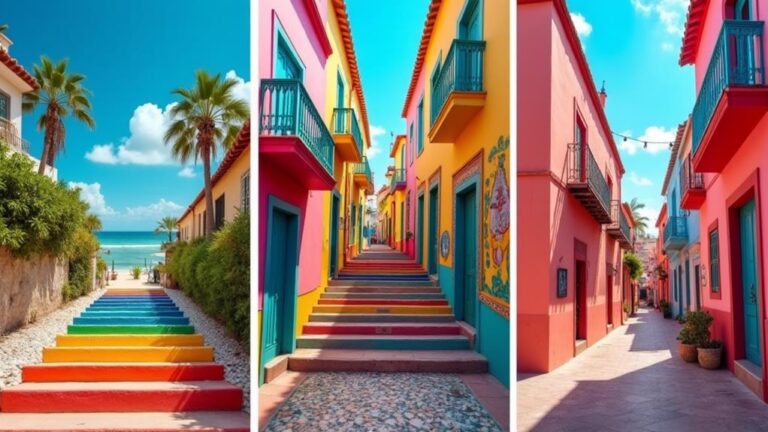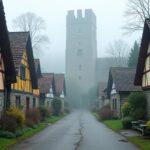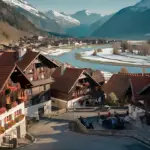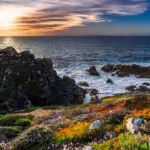As you step into the mystical world of Mexico's Mayan ruins, the ancient pyramids rise before you like giants from a forgotten era, their weathered stones bearing the secrets of a long-lost civilization. You're about to set out on a journey through the heart of Mexico's rich cultural heritage, where the remnants of a sophisticated society await your discovery. From the sun-kissed beaches of Tulum to the dense jungle ruins of Palenque, the remnants of the Mayan world are waiting to be explored. But which sites will leave you with the most lasting impressions, and what secrets will they reveal?
Contents
- 1 Key Takeaways
- 2 Chichen Itza's Pyramid City
- 3 Tulum's Seaside Ruins
- 4 Mayan History and Culture
- 5 Ek Balam's Ancient Wonders
- 6 Uxmal's Pyramid of the Magician
- 7 Coba's Jungle Ruins
- 8 Palenque's Hidden Temples
- 9 Calakmul's Ancient Metropolis
- 10 Mexico's Mayan Ruins Map
- 11 Frequently Asked Questions
- 12 Conclusion
Key Takeaways
- Chichen Itza's Pyramid of Kukulkan is a masterpiece of Mayan architecture, aligned with the rising and setting of the sun during equinoxes.
- Tulum stands out for its unique beachside location, perched on a cliff overlooking the Caribbean Sea and offering breathtaking views.
- Ek Balam features the El Torre Pyramid, one of the tallest in the Yucatan Peninsula, offering stunning views and ancient architecture.
- Palenque's exquisite architecture and mysterious energy make it a must-visit, with intricate carvings and ornate facades revealing Mayan craftsmanship.
- Calakmul showcases the grandeur of the Mayan civilization, with over 6,000 structures, including the Great Pyramid and Royal Tombs.
Chichen Itza's Pyramid City
Chichen Itza's Pyramid City is one of the most famous and mysterious sites in Mexico's Mayan ruins.
As you explore this ancient city, you'll discover the impressive Pyramid of Kukulkan, also known as El Castillo. This pyramid is a masterpiece of Mayan architecture, with a unique blend of pyramid architecture and ancient astronomy.
Built around 1100 AD, the pyramid is aligned with the rising and setting of the sun during the spring and fall equinoxes.
The pyramid's design is a monument to the Mayans' advanced knowledge of astronomy. During the equinoxes, a shadow in the shape of a serpent appears on the stairs, symbolizing the descent of Kukulkan, the feathered serpent god.
As you walk around the pyramid, you'll notice the intricate carvings and sculptures that adorn its walls, depicting scenes of Mayan mythology and daily life.
The pyramid's architecture is also notable for its use of Mayan engineering techniques, including the use of a stepped pyramid design and a central staircase.
As you climb to the top of the pyramid, you'll be rewarded with stunning views of the surrounding city and a deeper understanding of the Mayans' sophisticated understanding of astronomy and architecture.
Tulum's Seaside Ruins
As you explore Mexico's Mayan ruins, you'll find Tulum standing out due to its unique beachside location, perched on a cliff overlooking the Caribbean Sea.
This strategic placement made Tulum an important center for trade and commerce in the 13th to 15th centuries.
You'll learn about the rich history of the site, which dates back to the Post-Classic period and is characterized by its well-preserved architecture and stunning ocean views.
Tulum's Beachside Location
Perched atop a cliff overlooking the Caribbean Sea, Tulum's beachside location sets it apart from other Mayan ruins in Mexico.
As you explore the site, you'll notice the unique blend of coastal architecture and stunning natural scenery.
The ruins' seaside location offers breathtaking views and a chance to experience the site's dramatic setting.
- The proximity to the ocean influenced the design of Tulum's structures, with walls and buildings constructed to withstand the sea breeze and salt spray.
- The beachside location also facilitated trade and commerce with other coastal cities, highlighting the importance of Tulum's strategic position.
- The site's coastal setting makes it an ideal location for seaside exploration, with opportunities to swim, snorkel, or simply relax on the beach.
As you wander through the ruins, you'll appreciate the ingenuity of the Mayan builders, who carefully adapted their structures to the site's unique coastal environment.
Tulum's beachside location is a key aspect of its appeal, combining stunning natural beauty with a rich cultural heritage.
This unique blend of architecture and scenery makes Tulum a must-visit destination for anyone interested in Mayan ruins and coastal exploration.
History of the Site
Uncovering the history of Tulum's seaside ruins reveals a fascinating tale of a thriving Mayan city.
You'll discover that Tulum was a major port city and a strategic trade hub, connecting the Mayans to other civilizations in Mesoamerica.
The site was first inhabited around 1200 AD, and it reached its peak during the Post-Classic period, between 1200 and 1500 AD.
As you excavate further into the history of Tulum, you'll find that the site's discovery dates back to the 16th century, when Spanish conquistadors arrived on the Yucatan Peninsula.
However, it wasn't until the 20th century that systematic excavations and restorations took place, revealing the site's archaeological significance.
The site's well-preserved architecture, stunning location, and significant artifacts have made it one of the most important Mayan sites in Mexico.
Tulum's history is also marked by its unique architectural style, which reflects a blend of Mayan and Toltec influences.
The site's most famous structure, the El Castillo pyramid, is a monument to the advanced engineering skills of the Mayans.
As you explore the site, you'll uncover a rich history that showcases the sophistication and grandeur of the Mayan civilization.
Mayan History and Culture
As you explore the Mayan ruins in Mexico, understanding the Mayan civilization's rich history and culture is vital.
You'll discover that the Mayans were a sophisticated and complex society that flourished in Mesoamerica from 2000 BCE to 1500 CE, with a population of millions at its peak.
Mayan Civilization Overview
Deep within the Americas, a sophisticated and enigmatic civilization once flourished: the Maya.
As you plunge into the world of Mayan history and culture, you'll discover a complex society that left behind a rich legacy of Mayan achievements and ancient mysteries.
The Maya were a highly advanced civilization, with expertise in astronomy, mathematics, and architecture.
Some of their most notable accomplishments include:
- Developing a sophisticated writing system, which consisted of over 700 symbols, including logograms and phonetic symbols.
- Creating a highly accurate calendar system, which included three interlocking cycles: the Tzolkin, the Haab, and the Long Count.
- Building elaborate cities, with grand temples, palaces, and ball courts, which showcased their advanced engineering and architectural skills.
The Maya's advanced knowledge and skills have left many ancient mysteries that continue to intrigue and fascinate us today.
Their civilization was marked by a deep understanding of the universe, a strong spiritual connection to their gods, and a rich cultural heritage that continues to inspire wonder and awe.
Mayan Social Hierarchy
The Mayan civilization's sophistication and advancements weren't just limited to their writing systems, calendars, or architectural achievements.
They also had a complex social hierarchy that divided their population into distinct classes. You'll find that the Mayan society was broadly divided into three main social classes: the nobility, the commoners, and the slaves.
The Mayan aristocracy, comprising the king, nobles, and high-ranking officials, formed the top rung of the social ladder.
This class held immense power and wealth, controlling the economy, politics, and social life. They were responsible for making important decisions, conducting rituals, and overseeing the construction of monumental architecture.
Below the nobility were the commoners, who made up the bulk of the Mayan population.
They were primarily farmers, artisans, and traders, responsible for the daily functioning of society. The commoners were further divided into sub-classes, with farmers and artisans holding higher social status than traders.
At the bottom of the social hierarchy were the slaves, who were often prisoners of war or people who couldn't pay their debts.
They performed menial tasks and were at the mercy of their masters. Understanding the Mayan social hierarchy helps you appreciate the complexities of their civilization and the way their society functioned.
Ek Balam's Ancient Wonders
You'll find Ek Balam, one of Mexico's most fascinating Mayan ruins, nestled in the heart of the Yucatán Peninsula.
This Forgotten City, once a thriving metropolis, is now a treasure trove of Ancient Architecture waiting to be explored.
As you wander through the site, you'll discover the remnants of a sophisticated civilization that dates back to the 2nd century AD.
Some of the highlights of Ek Balam include:
- The El Torre Pyramid: This 31-meter-tall structure is one of the tallest pyramids in the Yucatán Peninsula and offers breathtaking views of the surrounding jungle.
- The Sacred Cenote: A large, natural sinkhole that was once used for human sacrifices and other rituals.
- The Plataforma 1: A large, raised platform that was once the site of a grand temple.
Ek Balam's unique architecture and stunning natural surroundings make it a must-visit destination for anyone interested in exploring Mexico's rich Mayan heritage.
As you explore the site, you'll gain a deeper understanding of the daily lives of the Mayan people and the significance of this Forgotten City in the region's history.
Uxmal's Pyramid of the Magician
One of Mexico's most impressive Mayan ruins is Uxmal, and at its heart lies the Pyramid of the Magician, a 35-meter-tall marvel of ancient engineering.
You'll be struck by the pyramid's unique elliptical shape, a distinctive feature of Uxmal's architecture. This pyramid is also known as the Pyramid of the Soothsayer, reflecting the Mayans' fascination with ancient astronomy.
The pyramid's design is aligned with the movements of the planet Venus, which was an important celestial body in Mayan mythology.
As you explore the pyramid, you'll notice that its architecture is divided into five levels, each representing a different phase of the Mayan cosmos.
The pyramid's design reflects the Mayans' advanced understanding of astronomy and mathematics. You can climb to the top of the pyramid for breathtaking views of the surrounding jungle and the rest of the Uxmal ruins.
The Pyramid of the Magician is an unforgettable experience that offers a glimpse into the sophisticated culture and knowledge of the Mayan civilization.
Coba's Jungle Ruins
Deep in Mexico's lush jungle lies Coba, another ancient Mayan city that's steeped in mystery and history.
As you explore the ruins, you'll discover a complex network of Sacred Pathways that were once used by the Mayans for trade, commerce, and spiritual journeys.
Coba's Jungle Ruins are a must-visit destination for anyone interested in the rich history and culture of the Mayan civilization.
To fully experience the magic of Coba, you'll need to be prepared for some Jungle Trekking.
The ruins are scattered throughout the jungle, and the only way to see them is by hiking or biking along the ancient pathways.
Here are a few things to keep in mind as you plan your visit:
- Wear comfortable shoes and clothing, as you'll be doing a lot of walking and hiking.
- Bring plenty of water and snacks, as the jungle can be hot and humid.
- Consider hiring a guide who can provide insight into the history and significance of the ruins.
With its ancient temples, pyramids, and ball courts, Coba's Jungle Ruins are a truly unforgettable experience.
Palenque's Hidden Temples
Beyond the dense foliage of Mexico's jungle lies Palenque, a Mayan archaeological site renowned for its exquisite architecture and mysterious energy.
As you explore the site, you'll uncover the secrets of Palenque's hidden temples, tucked away along winding jungle pathways.
The temples' intricate carvings and ornate facades reveal the advanced craftsmanship of the Mayans.
You'll discover the Temple of the Inscriptions, a magnificent structure that holds many temple secrets.
This temple is famous for the tomb of Pakal the Great, a Mayan ruler whose sarcophagus is adorned with intricate carvings.
The temple's architecture is a monument to the Mayans' knowledge of astronomy and mathematics.
As you wander through the jungle pathways, you'll stumble upon the Temple of the Sun and the Temple of the Cross, both of which boast stunning architecture and mysterious energy.
The temples' intricate carvings and ornate facades reveal the stories of the Mayans' daily lives, their mythology, and their connection with the natural world.
Calakmul's Ancient Metropolis
Calakmul's ancient metropolis sprawls across the Petén Basin in Mexico's northern jungle, an archaeological site that showcases the grandeur of the Mayan civilization.
As you explore this vast site, you'll discover the remnants of a once-thriving city, hidden deep within the jungle.
The ruins of Calakmul reveal the sophisticated urban planning and ancient architecture of the Mayans, with over 6,000 structures identified, including temples, palaces, and pyramids.
Some of the notable features of Calakmul include:
- The Great Pyramid, also known as Structure II, which rises over 55 meters above the jungle floor
- The Royal Tombs, discovered in the 1980s, which offer a glimpse into the lives of Calakmul's ruling elite
- The numerous plazas and courtyards, which provide a sense of the city's layout and organization
Jungle exploration is a must when visiting Calakmul, as the ruins are surrounded by dense foliage.
As you make your way through the underbrush, you'll encounter a variety of wildlife, including monkeys, birds, and even the occasional jaguar.
The experience of exploring Calakmul's ancient metropolis is a unique blend of history, culture, and adventure.
Mexico's Mayan Ruins Map
Exploring Mexico's Mayan ruins often involves traversing through dense jungle and deciphering ancient hieroglyphs, making a map an essential tool for any traveler or historian.
A Mexico's Mayan ruins map can help you navigate the vast regions of the Yucatan Peninsula, Tabasco, and Chiapas, which are home to numerous archaeological sites.
You can use regional guides to identify the most significant ruins, such as Chichen Itza, Tulum, and Palenque.
A map can also aid in planning your ruins itineraries, allowing you to prioritize the sites you want to visit and create a realistic travel schedule.
By looking at a map, you can see how the different ruins are connected, making it easier to plan your transportation and accommodations.
Additionally, a map can help you identify the lesser-known ruins, such as Ek Balam and Coba, which can be just as fascinating as the more popular sites.
Overall, a Mexico's Mayan ruins map is an indispensable resource for anyone looking to explore the rich history and culture of the Mayan civilization.
It's a tool that can enhance your travel experience and provide a deeper understanding of this ancient culture.
Frequently Asked Questions
Can You Visit Mayan Ruins With a Disability?
You can visit many Mayan ruins with a disability, as some sites offer accessible paths and wheelchair ramps, but verifying is crucial to research each location beforehand to guarantee they meet your specific needs and requirements.
How Much Do Mayan Ruin Tours Typically Cost?
You'll pay varying prices for Mayan ruin tours, but expect $60-$150 per person for a day trip. Tour operators often offer package deals, including transportation and guides, which can be more cost-effective for you.
Are Mayan Ruins Suitable for Young Children?
You're planning a family trip, but wonder if ancient sites are suitable for young kids. Fortunately, many Mayan ruins offer kid-friendly activities and stroller accessibility, making them a great destination for families with little ones in tow.
Can You Climb All the Mayan Pyramids?
You can't climb all pyramids due to safety concerns and preservation efforts. Pyramid access varies by site, with some allowing limited climbing, while others, like Chichen Itza's El Castillo, have strict climbing restrictions in place.
Do I Need Vaccinations to Visit Mayan Ruins?
You're venturing into ancient history, but modern health concerns come first. Check travel advisories before heading to Mexico, as some areas require vaccinations like Hepatitis A and typhoid fever to guarantee a safe and healthy trip.
Conclusion
As you leave the Mayan ruins behind, you're not just walking away from ancient stones – you're closing a chapter on a civilization that's left an indelible mark on history. The Mayan legacy is a tapestry of mystery and wonder, woven from the threads of a sophisticated culture that's as vibrant as the jungle that's reclaimed it. Its secrets will haunt you, beckoning you to return and unravel the mysteries of this ancient world.

